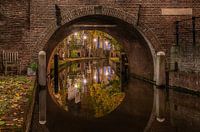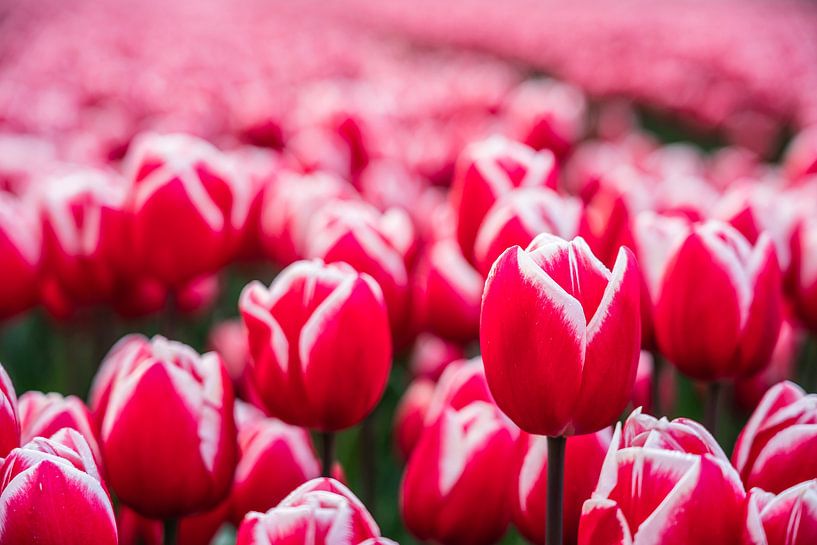Buy this flower art A sea of red on the tulip field by Jeroen de Jongh Photography on canvas, ArtFrame, poster and wallpaper, printed on demand in high quality.
About "A sea of red on the tulip field"
by Jeroen de Jongh Photography
About the artwork
Tulip is a genus of single-seeded plants in the lily family. Tulips were introduced to the western world by Vienna's ambassador to Turkey, Ogier Gisleen van Busbeke, who wrote about the flowers he had seen in Edirne, Turkey, in 1551. He later sent some of its seeds to Austria, and the arrival of a cargo of tulip bulbs from Turkey in Antwerp in 1562 marked the beginning of European tulip cultivation.
The first documented specimens were planted by the Fleming Carolus Clusius in the Hortus botanicus Leiden, which he ran from 1593. Ottoman sultans wore a tulip on their turban as a symbol. Tulips originally came from the area that became known as Kazakhstan, then part of the Ottoman Empire.
The genus's range extends from the Iberian Peninsula through North Africa to Greece, the Balkans, Turkey, the Middle East, Syria, Israel, Lebanon, Jordan, Iran, Ukraine, southern Siberia, Mongolia and north-western China.
Tulips need a cold night and a cold winter to grow, which means they cannot be grown in warm climates. New bulbs are grown by planting tulip bulbs in autumn. Over 75% of cultivated tulip bulbs are destined for flower production at home or abroad. The rest are sold to consumers as flower bulbs or end up in parks and public gardens. The flowering period runs from April to June.
In the 17th century (circa 1630 - 1637), a bizarre tulip mania developed around the tulip bulb in the Dutch Republic. Suddenly, tulip bulbs became speculative commodities. The craze drove up prices to exorbitant levels, even until the bulb was worth its weight in gold. The craze was at its peak in late 1636, early 1637. In February 1637, the 'bulb market' collapsed as suddenly as it had arisen. Many bulb speculators were left penniless.

About Jeroen de Jongh Photography
I'm Jeroen, and I'll spare you the long introduction. ;) If you're looking for a landscape photo for your wall, you've come to the right place... Read more…
 Netherlands
Netherlands Ordered in August 2021
Ordered in August 2021
 Netherlands
Netherlands Ordered in April 2019
Ordered in April 2019
 Netherlands
Netherlands Ordered in July 2021
Ordered in July 2021
 Netherlands
Netherlands Ordered in May 2021
Ordered in May 2021
 Netherlands
Netherlands Ordered in August 2021
Ordered in August 2021
 Netherlands
Netherlands Ordered in March 2017
Ordered in March 2017
 Germany
Germany Ordered in September 2020
Ordered in September 2020
 Netherlands
Netherlands Ordered in August 2019
Ordered in August 2019
 Netherlands
Netherlands Ordered in March 2022
Ordered in March 2022
 Netherlands
Netherlands Ordered in May 2023
Ordered in May 2023
 Germany
Germany Ordered in November 2020
Ordered in November 2020
 Germany
Germany Ordered in June 2020
Ordered in June 2020
About the material
Canvas
A classic and timeless material
- Fine-art print quality
- Frame made of sustainable wood
- Durability of minimum 10 years
- Available with floater frame
Discover the artworks of Jeroen de Jongh Photography
 Full moon at the flower marketJeroen de Jongh Photography
Full moon at the flower marketJeroen de Jongh Photography Lange HavenJeroen de Jongh Photography
Lange HavenJeroen de Jongh Photography Scheveningen PierJeroen de Jongh Photography
Scheveningen PierJeroen de Jongh Photography Lighthouse StavorenJeroen de Jongh Photography
Lighthouse StavorenJeroen de Jongh Photography April 25th BridgeJeroen de Jongh Photography
April 25th BridgeJeroen de Jongh Photography OosterdokJeroen de Jongh Photography
OosterdokJeroen de Jongh Photography Climb to the lightJeroen de Jongh Photography
Climb to the lightJeroen de Jongh Photography MonnickendamJeroen de Jongh Photography
MonnickendamJeroen de Jongh Photography Zonnepad MonnickendamJeroen de Jongh Photography
Zonnepad MonnickendamJeroen de Jongh Photography Mill de Vlinder on a misty morning in the BetuweJeroen de Jongh Photography
Mill de Vlinder on a misty morning in the BetuweJeroen de Jongh Photography Town Hall of Gouda at the MarketJeroen de Jongh Photography
Town Hall of Gouda at the MarketJeroen de Jongh Photography Swans at the skyline of ZutphenJeroen de Jongh Photography
Swans at the skyline of ZutphenJeroen de Jongh Photography Hoorn's Hoofdtoren in the mistJeroen de Jongh Photography
Hoorn's Hoofdtoren in the mistJeroen de Jongh Photography Peace and quiet at Schiedam's Lange HavenJeroen de Jongh Photography
Peace and quiet at Schiedam's Lange HavenJeroen de Jongh Photography Autumnal vista at Utrecht's Paulus BridgeJeroen de Jongh Photography
Autumnal vista at Utrecht's Paulus BridgeJeroen de Jongh Photography Tram 47 passes over the Freedom Bridge in BudapestJeroen de Jongh Photography
Tram 47 passes over the Freedom Bridge in BudapestJeroen de Jongh Photography Rapeseed at sunrise in Werk aan de GroenewegJeroen de Jongh Photography
Rapeseed at sunrise in Werk aan de GroenewegJeroen de Jongh Photography Sunset at the Tower of Ransdorp in AmsterdamJeroen de Jongh Photography
Sunset at the Tower of Ransdorp in AmsterdamJeroen de Jongh Photography Morning light at the Blauwe Wip windmillJeroen de Jongh Photography
Morning light at the Blauwe Wip windmillJeroen de Jongh Photography Full moon over Utrecht's Oudegracht canalJeroen de Jongh Photography
Full moon over Utrecht's Oudegracht canalJeroen de Jongh Photography













 Bokeh
Bokeh Depth of Field
Depth of Field Europe
Europe Flowers
Flowers Joyful Moments
Joyful Moments North Holland
North Holland Photo wallpaper
Photo wallpaper Photography
Photography Romantic Moments
Romantic Moments Serene Peace
Serene Peace The Netherlands
The Netherlands Tulip
Tulip Vibrant Colors
Vibrant Colors Waiting room
Waiting room









